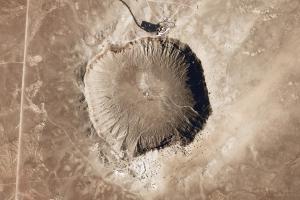Blog
Found and Lost
10 May 2023
 C Agee, Institute of Meteoritics, UNM; NASA
C Agee, Institute of Meteoritics, UNM; NASAAlthough they are thought of as rare, meteorites are actually quite common. About 40,000 tons of meteorites strike Earth every day. Most of them land in the ocean, and most are quite tiny, but they are still common enough that hobbyists all over the world find meteorites all the time. The most common place to find them is in arid regions where their coloring can stand out from the terrain. But even then a meteorite can be difficult to distinguish from terrestrial rocks.
There are, however, a few ways to distinguish them, and one of them stems from the fact that meteorites are usually magnetic. Because of this, meteorite hunters often carry a small hand magnet. If you swipe the magnet over a suspected meteorite, it will generally be more attracted to the magnet than nearby material. But as a recent study shows, this magnetic trick can also ruin important data about the formation of our solar system.1
 USGS
USGSMeteorites are fragments of debris from asteroid collisions. Sometimes these fragments were flung from the Moon or Mars due to large impacts, but usually they are the debris from asteroids colliding with each other. They are part of the remnant material from when the solar system formed. They formed within the protoplanetary disk of the Sun and interacted with the early Sun’s magnetic field as they formed. Because of this, meteorites carry a chemical and magnetic record of their origin. When meteorite hunters use a magnet to find meteorites, they can re-magnetize it, thus wiping its original magnetism.
As a case in point, the team had looked at a meteorite known as Black Beauty. It was discovered in the deserts of Northwest Africa in 2011. It’s a relatively large meteorite, with a mass of about 320 grams. But the reason it’s so important to astronomers is that it came from Mars. Analysis of Black Beauty has found crystals within it that formed 4.4 billion years ago. From Black Beauty, we know that early Mars was warm and wet.
Mars may have had a strong magnetic field during this time, and if so, Black Beauty held the evidence for it. But when the team looked at the magnetism of the meteorite, they found its original magnetic field had been wiped by exposure to magnets on Earth. The team also looked at several smaller fragments from Black Beauty and found that all but a few of them had been remagnetized.
In this latest study, the team examined how meteorites can be remagnetized. It is surprisingly easy. Exposure to simple hand magnets is enough to wipe a meteorite’s magnetic history. So the team is putting out a call for meteorite hunters to stop using magnets in their searches. It’s a big ask, given how cheap and useful hand magnets are, but if hobbyists work together with scientists, there is a wealth of information that can be preserved.
Vervelidou, Foteini, and Benjamin P. Weiss. “Hand magnets and the destruction of ancient meteorite magnetism.” Journal of Geographical Research: Planets (2023). ↩︎